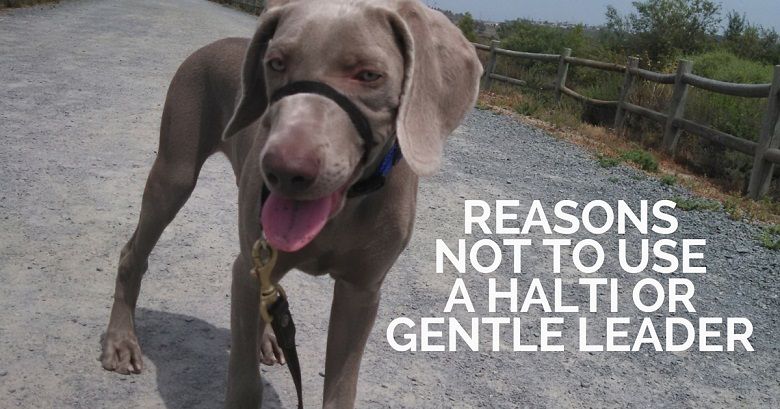Note: I personally love the Gentle Leader, but it’s not perfect. Thank you to Ty Brown of CommuniCanine for sharing these tips on why he does not recommend a Gentle Leader or a Halti.
I get a lot of flak for this in the dog training community, but I am not a fan of the Halti, Gentle Leader and No-Pull Harnesses. I am currently raging a war of one against these training tools and am losing ground quickly. No worries, though. Like the captain that goes down with the ship, I’ll continue my fight until the bitter end.
In my battle on these training tools I come fully armed with ammunition.
My war on the Halti/Gentle Leader
1. I see these tools as a gimmick.
They rarely teach the concept of proper leash walking. Rather, they tend to teach the dog not to pull while the gimmick is on. There is very little technique used with these tools. For that reason I think of them as a band-aid. They cover up the problem but do very little to fix it.
When I am helping a client teach his or her dog to walk on a loose leash, I use training tools such as a pinch collar, flat collar or slip collar.
With those collars, though, I teach my clients a great deal of technique. Technique is what teaches the concept of how to walk properly on a leash and what allows that owner to eventually wean the dog off the training collar. When someone depends on a harness or head collar to walk properly, then the owner is forever tied to that implement and the dog has essentially never learned to walk on a loose leash.

I’m sure there are those who have weaned their dogs off the head halter but they certainly did so using a great deal of technique. Most people will find themselves forever attached to a tool.
2. Haltis and Gentle Leaders are often very uncomfortable and distract the dog from the task at hand: walking!
If I had a nickel for every time a client complained that her dog wouldn’t stop itching at his face and head, scraping his face against the ground or going into a death roll to try to get the material off his head I’d have enough for a meal at McDonald’s – supersized!
A training tool should be like an accessory. It should be a normal thing to which the dog doesn’t pay attention. Many dogs find it hard to ignore a mesh of nylon all over their faces.
3. Head harnesses can worsen aggression issues.

Dogs create associations with the actions they are currently involved in and what they are currently focused on. Dogs that have aggression issues are prone to lunge at the objects of their aggression. In the act of lunging it can be very difficult to control a dog if they are on a head or body harness.
Not only that, but picture what the dog is experiencing. All of his focus is placed on the target of his aggression when suddenly his neck gets twisted from the lunge. Many dogs are prone to associate that pain in their neck with the object of their aggression and therefore the aggression becomes worse.
Many dogs will feel that the object of the aggression caused their pain and therefore they end up having worse feelings for the other dog, person, etc.
I have given several reasons why I am battling these harness style collars. I’m sure there are those who are able to avoid these pitfalls with their training techniques. My experience shows, however, there is a much better way.
Whichever training tools you use with your dog, make sure that you are using them in a humane fashion and ensure they are used as teaching tools rather than punishment tools.
Happy training!
Do any of you use a Halti to walk your dogs?
Check out my interview with Ty on protection dogs and his website Ty the Dog Guy for more info.

Mary Jo
Thursday 21st of May 2020
I read your article from 2008 about the Gentle Leader vs. Halti and that you like the Halti better. Praising the good points about both of them with the Halti coming out on top. You referenced this article in the 2008 on so then I read this one. So now in 2009 you don't like the "head collars" at all? I'm confused. Are they good or not?
Lindsay Stordahl
Thursday 21st of May 2020
Hi Mary Jo. This article (2009) was a guest article by a dog trainer who is a friend of mine, Ty Brown. He does not prefer to train with them. I personally love them for some dogs. It's personal preference and depends on the dog. No right or wrong. They don't work well for my current dog in 2020, a weimaraner. He pulls too hard on it, holds his breath and puts his head low and won't pant. It worked beautifully for my Lab mix Ace however.
kiarra
Wednesday 5th of December 2018
I use the halti with my border collie, hell if its a bandaid i dont care. It keeps her safe, it keeps us safe, it keeps others safe. She is well behaved with it on with positive reinforcement and she loves what it means when we get it out- walkies! She does not pull my arm out of the socket when we walk and she listens and pays attention with it on, instead of going tunnel vision into stalker mode. I have done extensive training with halti's in the past and they have been great, but i do think it really depends on who is the dog handler and what experience they already have.
Cristina
Monday 27th of August 2018
I check the website listed, and sorry but I won't take advice from a trainer that use shock collars. Studies done by veterinary behaviorists (note that trainer are almost never qualified behaviorists) shows that pain is not the way to teach dogs under any circumstances. Dog are smart creatures,and if someone doesn't have the patience and/or the time to train a dog to walk properly on leash the head collar is an alternative to be pull on the ground. Like any tool when the dog has learned that the tool is uncomfortable it can be eased off it. There is no magic tool that will do any training for you,but as I said before dogs are clever creatures and they want to please,reward your dog,praise it and you will be amaze how easy is to have a good canine citizen.
Lindsay Stordahl
Monday 27th of August 2018
I love the Halti, but for my particular dog, he pulls so hard on it that it causes discomfort that looks like pain. It leaves marks on his muzzle. For this reason, I rotate the collars I use with him because they are all uncomfortable for him to an extent. The no pull harnesses make him raw under the arms and chain collars make his neck red. To a dog, these tools can all be uncomfortable.
Suzy
Wednesday 18th of May 2016
I agree that the dog won't necessarily learn to walk properly without the halti but you are wrong on all of the other points you are trying to make.
Obviously you'd have to pick the right collar. One that doesn't chafe or irritate. And you have to take the time to fit it correctly. You have to have the patience and sense to help the dog associate the harness with good things like treats and belly rubs.
Of course the dog won't like it. Children don't like to come in from playing to sit on the toilet, either! They don't like to wash their hands before dinner. But we make them because we know what's best.
I've also never seen a walking harness that puts mesh all over a dog's face or the injured a dog.
You'd have been much better off sticking with the fact that the animal isn't learning anything using the halter and more importantly with a big dog like mine, the fact that the human is not showing dominance by using a halter.
Less than a month ago my health started unexpectedly deteriorating. My bones started sliding in and out of joint unexpectedly. It happens fast enough that I don't fall or anything, but I certainly can't have a big dog yanking me around now like I could have when I got her. I'd raised a rottie and knew exactly what I was getting into. There was no way I could have planned for this.
The fact of the matter is, at six months old, my rott weighs half what I do. She'll soon weigh what I do or close to it.
Ros
Monday 2nd of May 2016
I have been using haltis for many years, they generally work, but not with a big powerful male, now I want to try a no pull harness.